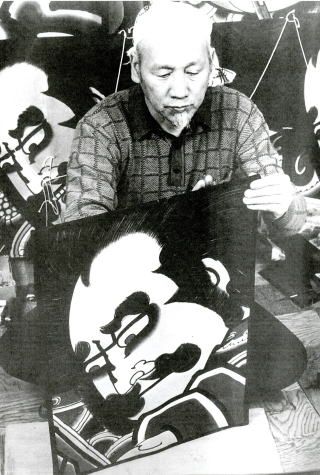| |
NAKANO Keizo
|
|
Artist – NAKANO Keizō (中野敬造 Keizō) was born in 1929 in
Hirosaki, now part of Tsugaru City in Aomori Prefecture to the
second generation kite builder NAKANO Keizaburo (中野啓三郎, 1903 -
1975). Tsugaru (つがる) is a city in Aomori Prefecture on Honshū,
the main island of Japan. The city's name is atypically but
officially written in hiragana.
It is said that during the Edo period (17-19c), nishiki-e with warrior pictures were brought back to Tsugaru as souvenirs by samurais attending the domains daimiyo during their regular and repeated stays at the bakufu court in Edo during the feudal era. Poverty stricken samurai families of Hirosaki took up kite making to make ends meet. Records indicate that during the Tempo era (1830-1844) of the Edo period, many kites were observed flying through the skies of Hirosaki, Tsugaru Domain's castle town (present day Aomori Pref.).
Warrior
pictures (Musha-e, 武者絵)
inherit the influence of the ukiyo-e, but It is not until the Meiji
period (19-20c) that samurais became depicted in the kites'
designs. The painting style, heavily influenced by Katsushika Hokusai, was
established by Shibata and later perfected by Odagiri Iwakura.
In addition, the depiction of warriors on the kites, they
serve as a symbol to express parents' wishes for their
children to grow up strong and tenacious.
The
Tsugaru region,
which is often closed by heavy clouds, cold wind and snow for
half a year, is symbolized as warrior
picture (Musha-e, 武者絵)
by the portrait of amilitary commander and his strength to
withstand the harsh natural climate. Keizo NAKANO's skill is
the expression of the military commander who feels the
strength and kindness to protect the family and the lonely
melancholy of fighting. His musha-e paintings are heavily
influenced by the ukiyo-e painters of Edo (present day Tokyo),
and subjects depicted are often heroes of legendary tales such
as the Sanguo Zhi (Records of the Three Kingdoms), Shui Hu
Zhuan (The Water Margin), and great Japanese warriors from
history. Use of wide, powerful brush strokes in equally strong
colors such as red, black, and green are predominant in the
Tako-e paintings.
After
the Second World War, kites had been in a blank era for quite
a long time. NAKANO started building kites in his familiar
tradition, In the 1965's, traditional kites from various
places were revived by preservation societies. NAKANO was part
of this movement.
NAKANO
has been building Tsugaru kites since 1947. He is a third
generation kite master of traditional Tsugaru kites, and has
published the book, 'Musha-e Hyakutai' (武者絵 百体, A Hundred
Kinds of Warriors Pictures) in 1986. NAKANO disclosed his
artistic technique of Musha-e (武者絵, warrior pictures) in this
book.
Bamboo is difficult to grow in the Tsugaru district because of the cold climate. Thus Tsugaru kites are different from other traditional Japanese kite because they have wooden frames made of thinly chopped Hiba tree (Thujopsis tree), a lightweight and supple cypress. On the back side of the Tsugaru tako is a thick paper strip attached, called the "bumbu". When the kite is flown the bumbu vibrates, making a buzzing noise as it soars through the skies. Despite the wooden frames, the "bumbu", and the traditional musha-e drawings, these kites follow the design type of Edo kites.
Personal
life - NAKANO Keizo died in 2006 in Hirosaki,
Tsugaru.
Aliases - none
Disciples - no known disciples
Copyright 2008 ff: Hans P. Boehme
